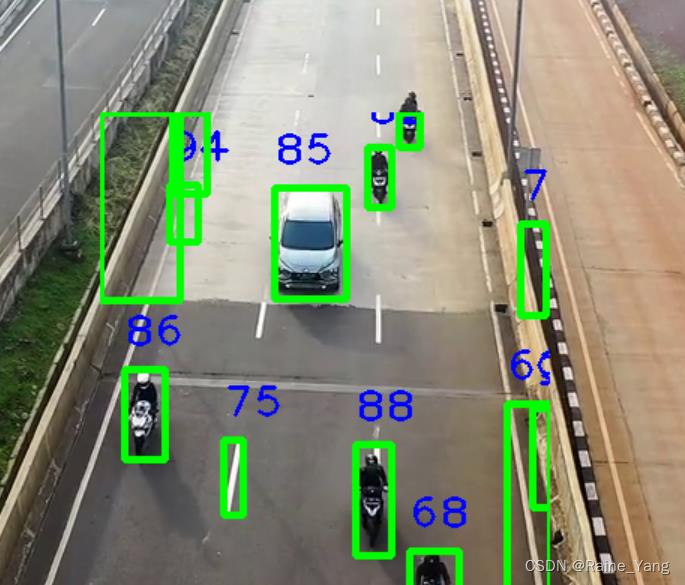(项目笔记)OpenCV目标检测程序
Posted Raine_Yang
tags:
篇首语:本文由小常识网(cha138.com)小编为大家整理,主要介绍了(项目笔记)OpenCV目标检测程序相关的知识,希望对你有一定的参考价值。
本跟踪程序核心为OpenCV里BackgroundSubtractorMOG2()类。该类通过对当前帧和背景模板的每个像素做减法,来区分前景和背景物体。这一算法只适用于背景相对固定的情况,如固定摄像头。对于跟踪小车这种需要实时更新背景的情况不适用
1 Tacker类:标记并更新获取到的目标
import math
class EuclideanDistTracker:
def __init__(self):
# Store the center positions of the objects
self.center_points =
# Keep the count of the IDs
# each time a new object id detected, the count will increase by one
self.id_count = 0
# record IDs of objects tracked
# @param: the rectangular frame that captures an object
# @return: objects boxes and ids
def update(self, objects_rect):
# Objects boxes and ids
objects_bbs_ids = []
# Get center point of new object
# time complexity O(N^2)
for rect in objects_rect:
# find the center of the object
x, y, w, h = rect
cx = (x + x + w) // 2
cy = (y + y + h) // 2
# Find out if that object was detected already
same_object_detected = False
# search the objects stored for the same object
for id, pt in self.center_points.items():
distance = math.hypot(cx - pt[0], cy - pt[1])
# if the distance between two objects detected are very close, we consider
# them to be one object
if distance < 25:
self.center_points[id] = (cx, cy)
print(self.center_points)
objects_bbs_ids.append([x, y, w, h, id])
same_object_detected = True
break
# New object is detected we assign the ID to that object
if same_object_detected is False:
self.center_points[self.id_count] = (cx, cy) # update center coordinates
objects_bbs_ids.append([x, y, w, h, self.id_count])
self.id_count += 1
# Clean the dictionary by center points to remove IDS not used anymore
new_center_points =
for obj_bb_id in objects_bbs_ids:
_, _, _, _, object_id = obj_bb_id
center = self.center_points[object_id]
new_center_points[object_id] = center
# Update dictionary with IDs not used removed
self.center_points = new_center_points.copy()
return objects_bbs_ids
1
self.center_points =
self.id_count = 0
center_points字典用于保存记录的中心点坐标。其键为物体标记,值为该物体的中心点x和y坐标
2
for id, pt in self.center_points.items():
distance = math.hypot(cx - pt[0], cy - pt[1])
# if the distance between two objects detected are very close, we consider
# them to be one object
if distance < 25:
self.center_points[id] = (cx, cy)
print(self.center_points)
objects_bbs_ids.append([x, y, w, h, id])
same_object_detected = True
break
在这一步我们通过新物体相当于之前标记过各个物体的位置,判断新检测到的一个物体是否为以前标记的物体。循环变量id为物体标记,pt为各个物体中心点坐标(pt[0] = x, pt[1] = y)
distance = math.hypot(cx - pt[0], cy - pt[1])
math.hypot(x, y)计算该点到原点的距离,相当于math.sqrt(x * x + y * y)。这一函数用于算出当前物体和已记录的第id个物体之间距离绝对值。如果此值小于25,我们认为这两个物体为同一个。接下来更新第id物体中心点坐标,并把更新后坐标和id添加到objects_bbs_ids,该二维列表保存每个物体的x,y坐标及长宽
3
if same_object_detected is False:
self.center_points[self.id_count] = (cx, cy) # update center coordinates
objects_bbs_ids.append([x, y, w, h, self.id_count])
self.id_count += 1
在上一步中,如果没有任何一个已标记的物体和被检测物体坐标相近,及判断该物体为新物体。把新物体赋予新id(id_count += 1),并添加到center_points和objects_bbs_ids里
4
new_center_points =
for obj_bb_id in objects_bbs_ids:
_, _, _, _, object_id = obj_bb_id
center = self.center_points[object_id]
new_center_points[object_id] = center
# Update dictionary with IDs not used removed
self.center_points = new_center_points.copy()
return objects_bbs_ids
这一步用于删除已消失的目标,防止center_points里保存太多无用坐标。我们将id存在在objects_bbs_ids里面的物体在center_points里予以保留,对剩余的物体随着更新删除。objects_bbs_ids里面为存在在本次函数调用时这一帧的所有已有和新添加的物体。
本程序只能区分物体和背景,无法对物体特征进行记录,因此如果一个物体离开画面后再次进入,会被赋予新的id
2 主方法
import cv2
from tracker import *
# Create tracker object
tracker = EuclideanDistTracker()
cap = cv2.VideoCapture("highway.mp4")
# Object detection from Stable camera
object_detector = cv2.createBackgroundSubtractorMOG2(history = 100, varThreshold = 50, detectShadows = True)
while True:
# get video height and width
ret, frame = cap.read()
height, width = frame.shape[0:2]
# Extract Region of interest
roi = frame[340: 720,500: 800]
# 1. Object Detection
mask = object_detector.apply(roi)
_, mask = cv2.threshold(mask, 254, 255, cv2.THRESH_BINARY)
contours, _ = cv2.findContours(mask, cv2.RETR_TREE, cv2.CHAIN_APPROX_SIMPLE)
detections = []
for cnt in contours:
# Calculate area and remove small objects
area = cv2.contourArea(cnt)
if area > 100:
# cv2.drawContours(roi, [cnt], -1, (0, 255, 0), 2)
x, y, w, h = cv2.boundingRect(cnt)
detections.append([x, y, w, h])
# 2. Object Tracking
boxes_ids = tracker.update(detections)
for box_id in boxes_ids:
x, y, w, h, id = box_id
cv2.putText(roi, str(id), (x, y - 15), cv2.FONT_HERSHEY_PLAIN, 2, (255, 0, 0), 2)
cv2.rectangle(roi, (x, y), (x + w, y + h), (0, 255, 0), 3)
cv2.imshow("roi", roi)
cv2.imshow("Frame", frame)
cv2.imshow("Mask", mask)
key = cv2.waitKey(30)
if key == 27:
break
cap.release()
cv2.destroyAllWindows()
1
object_detector = cv2.createBackgroundSubtractorMOG2(history = 100, varThreshold = 50, detectShadows = True)
创建OpenCV里面的BackgroundSubtractorMOG2对象,参数解释如下:
1 int history:用于训练背景的帧数。这一参数会影响训练背景的学习率(如果不手动设置学习率),帧数越大,学习率越小,训练越慢
2 int varThreshould: 方差阈值,用于判断当前像素前景和背景,如当前像素和背景图片差大于阈值及认定为前景。一般阈值设为16,在光照变化明显的情况下要提高,阈值越大检测越不灵敏
3 boolean detectShadows: 是否检测影子。如检测会提高程序时间复杂度
2
mask = object_detector.apply(roi)
_, mask = cv2.threshold(mask, 254, 255, cv2.THRESH_BINARY)
contours, _ = cv2.findContours(mask, cv2.RETR_TREE, cv2.CHAIN_APPROX_SIMPLE)
detections = []
for cnt in contours:
# Calculate area and remove small objects
area = cv2.contourArea(cnt)
if area > 100:
# cv2.drawContours(roi, [cnt], -1, (0, 255, 0), 2)
x, y, w, h = cv2.boundingRect(cnt)
图像二值化:
cv2.threshold(src, thresh, maxval, type[, dist])
src:传入灰度图像
thresh: 起始阈值
maxval:最大值
type:图像处理类型
使用THRESH_BINARY使得像素值大于thresh是像素值设为maxval,否则像素值设为0
使用findContours找出所有轮廓,删掉过小的噪点(大小小于100),然后将剩余物体轮廓用最小矩形标出
3
boxes_ids = tracker.update(detections)
for box_id in boxes_ids:
x, y, w, h, id = box_id
cv2.putText(roi, str(id), (x, y - 15), cv2.FONT_HERSHEY_PLAIN, 2, (255, 0, 0), 2)
cv2.rectangle(roi, (x, y), (x + w, y + h), (0, 255, 0), 3)
调用tracker的update方法更新物体标记,在图像上画出物体标记及矩形框标注物体
示例如下:

成功检测案例
2 
一旦摄像头出现移动导致背景改变,会出现大量错误检测。因此该算法只适用于背景固定的情况
以上是关于(项目笔记)OpenCV目标检测程序的主要内容,如果未能解决你的问题,请参考以下文章